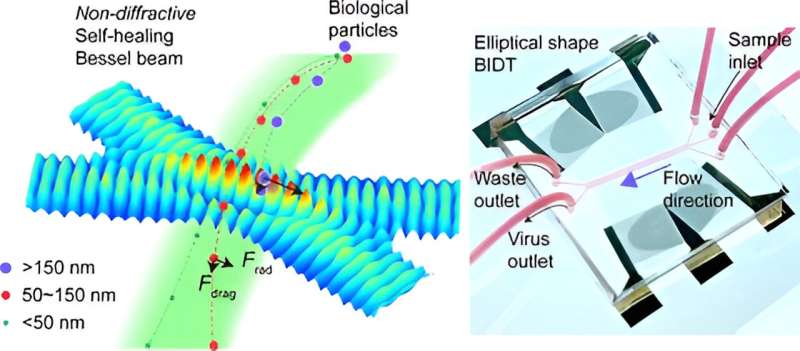This article has been reviewed according to Science X's editorial process and policies. Editors have highlighted the following attributes while ensuring the content's credibility:
fact-checked
peer-reviewed publication
trusted source
proofread
Separating viruses from saliva with sound waves for therapeutic studies

Developing antiviral therapeutics and vaccines requires close study of the viruses that cause disease. But how can these small germs be isolated from complex biological samples like saliva?
Researchers of a study appearing in ACS Nano describe a platform that uses sound waves as acoustic tweezers to sort viruses from other compounds in a liquid. In demonstrations, the method quickly and accurately separates viruses from large and small particles in human saliva samples.
Isolating, identifying and genetically sequencing a virus provides important information to scientists about how it causes disease and how to develop effective therapeutics. Current methods for separating viruses from other particles in biological samples include time-consuming ultracentrifugation and cell culture procedures.
To speed up and simplify the process, Luke Lee and Tony Jun Huang looked to acoustofluidics: a technology that uses sound waves to sort particles by size in a liquid. They chose a specific type of sound wave, called a Bessel beam, because it can be tuned to sort specific nanosized particles, and multiple waves remain tightly focused over long distances—like a pair of tweezers.
The Bessel beam excitation separation technology (BEST) platform that Lee, Huang and colleagues developed consists of a rectangular chip with a sample-loading inlet at one end and separate virus and waste outlets at the other end. Two acoustic Bessel beams were applied across the chip, perpendicular to the sample flow. By tuning the beams' wavelengths, the system sorted particles of different sizes:
- Large particles larger than 150 nanometers (nm) in diameter were trapped on the chip.
- Small particles smaller than 50 nm left through the waste outlet.
- Viruses of intermediate sizes (50 to 150 nm) were collected via the virus outlet.
The team tested the BEST platform on human saliva samples loaded with SARS-CoV-2. Liquid collected from the chip's virus outlet contained 90% of viral genetic material, while liquid from the waste outlet contained no viral genetic material, showing that the platform successfully isolated the virus. The researchers confirmed the results with electron microscopy, finding viruses only in liquid sampled from the virus outlet.
Although BEST cannot yet separate waste particles from viruses that are smaller than 50 nm, such as parvoviruses, the researchers are working to broaden the technology's range to enable its use in developing new therapeutic targets for numerous viral diseases.
More information: Jianping Xia et al, Acoustofluidic Virus Isolation via Bessel Beam Excitation Separation Technology, ACS Nano (2024). DOI: 10.1021/acsnano.4c09692
Journal information: ACS Nano
Provided by American Chemical Society





















